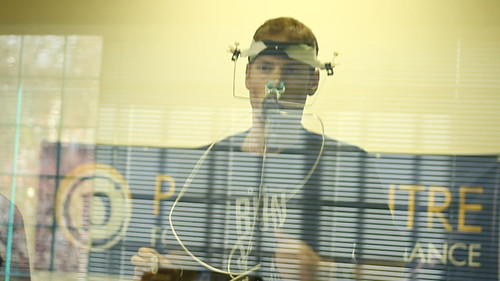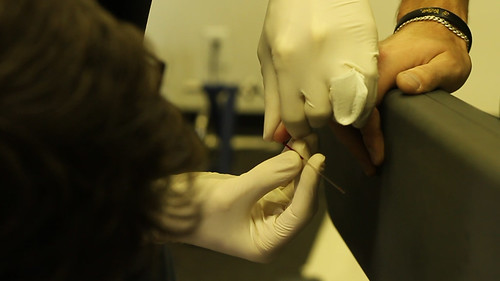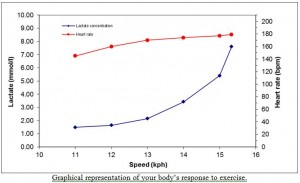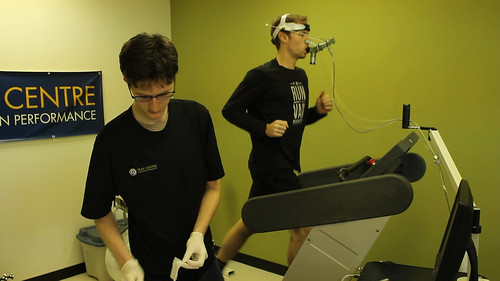 Video Stills by Jeff Pelletier
Video Stills by Jeff Pelletier
I’m currently training for the 2013 BMO Vancouver Marathon and am one of six official bloggers. Each week I’m providing updates on my training and experience leading up to May 5. You can read my first five posts here 1, 2, 3, 4, 5.
As I mentioned last week, I recently had a fitness assessment with Peak Centre for Human Performance. It was my first time doing an assessment, and was quite an experience. Ideally, this would have been done at the start of my training, but I’ve come away with a lot of great new information that I can use in my final two months leading up to the Vancouver Marathon.
First of all, what is the assessment? “A fitness assessment is a method of measuring your body’s specific response to exercise, it is a snapshot of your current fitness level.” What the test basically helped show me was the running pace at which I reach my lactate threshold, what my VO2 Max is, what my heart rate zones are, and how much fat and carbs am I burning while running in each zone (among some other cool things!).
I’ve never been one to get too into the data. I’ve never ever run with a heart rate monitor, and I’ve never raced with a watch/GPS. I’ve always had a GPS to measure the distance and overall average pace of my training runs, but have generally been happy to go by how I feel, or ‘perceived exertion’ for the most part. Well, that might be changing a bit now that I have all this nifty data at the ready.
The assessment itself was ‘fun’ in its own way. Basically, I was placed on a treadmill breathing into a mouth-piece that measured the oxygen inflow/outflow as I began to run. I ran slowly for three minutes, gave a small blood sample while continuing to run, and then the treadmill was sped up a bit. Then I ran for three more minutes, gave a blood sample, and the speed increased…. I think you get the picture. Eventually the treadmill got up to a painful speed, and I was running frantically trying to keep pushing myself while simultaneously sticking my finger out to give the blood sample and breathing furiously into the awkward tube. This happened for only about 17 minutes until I got to the point of nearly puking and had to stop. Fun!
I felt disappointed that I wasn’t able to run at least a few minutes further, but I’m blaming that on the head-cold I had during this (as witness by the huge pool of snot that flew out of my nose when the nose-plug was taken off me). More fun!
So that was the assessment. A few days later I went back to discuss the results with the fine folks at Peak and talked about how to relate this information into my training plan. First, we covered a lot of interesting physiological details about how muscle fibres work at different intensities, how lactate builds up, and all that good stuff. The neat thing about the assessment is you can see the specific running paces where you are able to control lactate build-up and the associated heart rate for the zones. You can then use that information to target training within specific zones for the sport you want to improve in. For a marathon, a lot of the training is in the lowest zone (Zone 1). It turns out that by following my training book and its best estimate of my fitness, I’ve been running at too slow of a pace, even for my Z1 (or easy, long run pace). To see improvement in the speed at which my body can comfortably control lactate build-up, I should be running at a pace of 4:23 to 4:55. 4:23 minutes/km also happens to be very close to my target race pace for hitting a 3:05 marathon. ie, I need to be doing a lot more runs which include a good chunk of time at that pace.
The most important part of the testing results are the blood lactate results. This is how we pinpoint your thresholds, your training zones, evaluate improvements and areas that require work. The reason we use lactate to determine your training zones is that lactate has a direct correlation to fatigue. Where you have high levels of lactate, you also have high levels of fatigue. Our goal through training is to lower the lactate level for each speed – that way you are producing less fatigue at each speed and able to go faster for longer.
The other recommendation was that I do some more work at Zone 5 (the highest intensity zone). This is also something I haven’t been doing. My speedwork has mostly been around 5 minute intervals (what is closer to my Zone 3), whereas to get into Zone 5 the intervals need to be 1-3 minute efforts at an even faster pace (faster than 3:40 per km). So it turns out I get to make my training even more painful now.
We also discussed fuelling and based on my carbohydrate consumption, I should apparently be taking in 81g of carbs per hour while at marathon goal-pace!! I don’t think I’ve ever come close to consuming that much during any run (Gu’s ain’t cheap yo!) but its something I’m going to try in some of my long training runs to see what I can stomach. It might help with some of the bonking I’ve experienced in my past 3 marathons.
So that’s basically the summary. It will be interesting to adapt all this information into my training plan and see if I can break into a new level of fitness in only a few months. I’m feeling a lot more confident that these changes to my training will help me get closer to 3:05 this May.







BMO Vancouver Marathon
That looks hardcore Karl! Keep up the great work.
Karl W
Thanks Kristine! It was a bit more science than I’m used to, to say the least. But hopefully there is a payoff!
Kristine Svehla-Brown
Love the science! It is awesome to try to figure out where you perform best and were you can “push it” based on your levels. I’ll try to remember this next time I seem to be stuck in the same gear. Best of luck with the rest of your training! Go Karl!